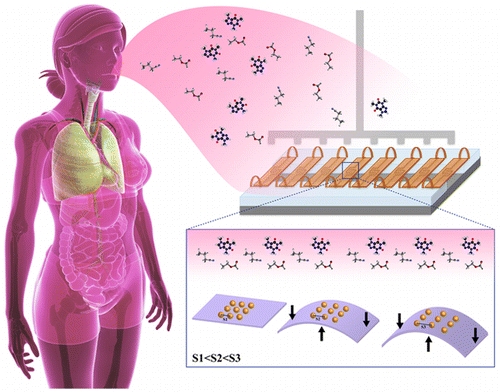Sniffing out cancer with improved 'electronic nose' sensors

Scientists have been exploring new ways to "smell" signs of cancer by analyzing what's in patients' breath. In ACS' journal Nano Letters, one team now reports new progress toward this goal. The researchers have developed a small array of flexible sensors, which accurately detect compounds in breath samples that are specific to ovarian cancer.
Diagnosing cancer today usually involves various imaging techniques, examining tissue samples under a microscope, or testing cells for proteins or genetic material. In search of safer and less invasive ways to tell if someone has cancer, scientists have recently started analyzing breath and defining specific profiles of compounds in breath samples. But translating these exhaled disease fingerprints into a meaningful diagnosis has required a large number of sensors, which makes them impractical for clinical use. Hossam Haick and colleagues sought to address this problem.
The researchers developed a small, breath-diagnostic array based on flexible gold-nanoparticle sensors for use in an "electronic nose." The system—tested on breath samples from 43 volunteers, 17 of whom had ovarian cancer—showed an accuracy rate of 82 percent. The researchers say developing this method further would require larger-scale clinical testing. They add that the approach could also apply to diagnostics for other diseases.
More information: Dynamic Nanoparticle-Based Flexible Sensors: Diagnosis of Ovarian Carcinoma from Exhaled Breath, Nano Lett., Article ASAP, DOI: 10.1021/acs.nanolett.5b03052
Abstract
Flexible sensors based on molecularly modified gold nanoparticles (GNPs) were integrated into a dynamic cross-reactive diagnostic sensing array. Each bending state of the GNP-based flexible sensor gives unique nanoparticle spatial organization, altering the interaction between GNP ligands and volatile organic compounds (VOCs), which increases the amount of data obtainable from each sensor. Individual dynamic flexible sensor could selectively detect parts per billion (ppb) level VOCs that are linked with ovarian cancers in exhaled breath and discriminate them from environmental VOCs that exist in exhaled breath samples, but do not relate to ovarian cancer per se. Strain-related response successfully discriminated between exhaled breath collected from control subjects and those with ovarian cancer, with data from a single sensor being sufficient to obtain 82% accuracy, irrespective of important confounding factors, such as tobacco consumption and comorbidities. The approach raises the hope of achieving an extremely simple, inexpensive, portable, and noninvasive diagnostic procedure for cancer and other diseases.
Journal information: Nano Letters
Provided by American Chemical Society















